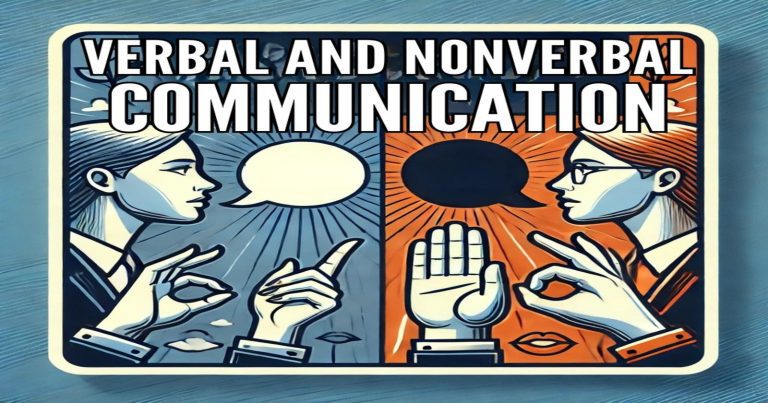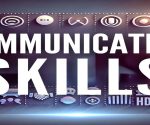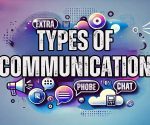Communication is an activity that involves the exchange of thoughts, ideas, and information among individuals. It is very vital in personal, professional, and social life. Verbal and non-verbal communication are the two significant ways of communication applied in daily life. Verbal communication is said to be made through spoken or written words. Non-verbal communication is achieved through gestures, facial expressions, body language, and other non-verbal signals. Such knowledge expands relationships, facilitates business interaction, and increases the overall effectiveness of messages. In this article, we will define verbal and non-verbal communication, talk about their types, advantages, and disadvantages, and try to find out their role in Business and everyday life.
What are Communication Skills?
Communication skills entail the adequate and proper expression of ideas. These are relevant to the everyday life-world, in one’s life, in expressing an idea, interacting with other individuals, fostering relationships, and having a mutual understanding. Good communication skills help in self-development, growth at work, and business success.
It helps people communicate since the information is transparent and cannot be prone to misinterpretation, and it can quickly be related to an audience. Information on communication skills encompasses more than speaking. It transcends to include listening, interpreting non-verbal signals, variations in tone and vocabulary based on the context, how to handle a conflict, successful negotiation, and influence.
Clear communication in the business environment boosts productivity, improves customer relations, and promotes teamwork. Practical communication skills, both in personal and professional life, help one achieve success. Good communication skills also facilitate job interviews, leadership positions, and networking.
Verbal and Non-Verbal Communication
Verbal communication is the use of spoken or written words to convey messages. It involves conversations, speeches, emails, reports, presentations, and discussions. People use verbal communication in their daily interactions, business meetings, and education. The effective use of verbal communication needs clarity, control of tone, and the proper usage of words. It lets the message be delivered as conveyed, thereby creating fewer possibilities for confusion.
Non-verbal communication is a way of communicating without using words. It involves facial expressions, gestures, posture, eye contact, and even voice tone. Non-verbal cues could be used for expressing emotions, intentions, and attitudes. A smile implies friendliness; crossed arms depict resistance. The body language and the facial expression will often say much more than what is said in words. All these things affect how a message is received.
More will be understood due to the complementarity of both kinds of communication. In Business, both verbal and non-verbal communication will gain momentum towards better clarity and a much stronger relationship. A confident handshake during a job interview may even endorse an impression of a good first impression. In the absence of cues, words seem dull and do not hold the power of an emotion.
Types of Verbal Communication
Verbal communication can be categorized into oral and written forms, including face-to-face conversations, speeches, phone calls, emails, and text messages. It helps convey information clearly through words, tone, and language choice.
Oral Communication
Oral communication refers to face-to-face communication, speeches, phone calls, and meetings. Oral communication is used in social, educational, and professional life. Clarity in pronunciation, tone, and confidence adds to the quality of oral communication. Even listening skills go into effective oral communication because listening to the listener’s response is also equally important.
Written Communication
This includes written communication like letters, emails, reports, and text messages. Record-keeping and formal usage of communication are provided. Written communication’s essence is accuracy, grammar, and structure. Since words spoken do not leave a permanent record, there is much need for written communication in legal documents, official agreements, and professional correspondences.
Formal Communication
Formal Communication can be implemented in the business environment, education and government. Such communication observes formal rules and etiquette of work that include reports as well as formal announcements. Professionalism is established, and clarity is maintained in structured organizations. It is essential for legal compliance, official procedure, and corporate decisions.
Informal Communication
Informal communication occurs during informal communication, messages from personal relationships, and one-way social media communication. It is more relaxed and spontaneous. Building relationships, encouraging teamwork, and hence producing a comfortable workplace increases informal communication. It is usually practised among friends, colleagues, and family members.
Types of Non-Verbal Communication
Non-verbal communication includes body language, facial expressions, gestures, eye contact, posture, and tone of voice. It helps convey emotions, reinforce messages, and enhance understanding without using words.
Facial Expressions
Facial expressions can show emotion and reaction without one having to utter a word. Facial expressions are also generally universal. Facial expressions convey meaning and reactions in such a way that, sometimes, people can see right through their words with a simple glance.
Gestures
Hand movement, nodding, and pointing emphasise the message being conveyed with meaning attached to it. Gestures supplement the spoken words and give more clarity to the conversation. However, gestures may mean different things in different cultures and should be used with caution when communicating internationally.
Body Language
Posture, stance, and body movements could convey confidence, nervousness, or openness. The more relaxed the person is trying to be, the more effort they will make to appear confident, but a slouch may suggest the individual isn’t interested in meeting or even lacks energy. A person could gauge other people’s feelings pretty well from their body language.
Maintaining eye contact is a sign of confidence and attentiveness, but avoiding the eyes may indicate discomfort. In a professional environment, eye contact is a sign of trust and credibility. However, in some cultures, staring too much is considered rude or aggressive.
Voice Tone
How words are pronounced- that is, pitch, rate, and loudness- alters the message’s impression. A gentle, soft tone gives an impression of kindness, whereas a harsh tone presents annoyance and frustration. This is the power of tone for changing word meaning.
Physical Touch
Support, reassurance, or dominance through a handshake, pat on the back, or hug. A firm handshake is positive in professional settings, and more physical contact may not be appropriate.
Knowing kinds of verbal and non-verbal communication helps in better interactions between people in personal or professional fields. It aids in properly presenting ideas, enriches relationships, and prevents mistaken impressions in people.
Advantages of Verbal Communication
The benefits of oral communication are that it allows for quick exchanges, immediate reaction and interaction clarity. It helps to create relationships, express emotions and solve misconceptions effectively.
Quick and direct
People can immediately express messages through speech, which can make it ideal for discussion, talks and problems. This crisis makes oral communication necessary for management and decision making.
Clarity and Immediate Feedback
Verbal communication allows clarification and instant response, reducing misunderstandings. It enables real-time adjustments based on the listener’s reactions.
Personal Connection
It builds relations since emotions, tone, and expressions are integrated into the message. Trust and engagement with the audience enhance face-to-face communication.
Persuasive and Engaging
Verbal communication allows for making influential decisions, providing powerful speeches, and promoting collaboration. An articulate orator can motivate and empower people.
Flexible and Versatile
The tone, volume, and words used can vary depending on the audience or situation. Such flexibility makes verbal communication very effective in most situations.
Disadvantages of Verbal Communication
Verbal communication can lead to misunderstandings due to differences in tone, language, or interpretation. It also lacks a permanent record, making it less reliable for future reference.
Misunderstood
Words may be misinterpreted if the tone, accent, or pronunciation is not clear. Competency in language might also cause misunderstanding.
Lack of Record
When the discussion is completed, the spoken words are eradicated. This means that it becomes impossible to refer to the debate, which is problematic in some legal or Business matters.
Language
Misconceptions arise from differences in language, dialect, or vocabulary. International communication mainly involves translation and interpretation.
It takes a long time to have such discussions, and it might not be worth it in a time-driven scenario. In this way, it may consume the most crucial time in negotiations and meetings.
Dependence on Listening Skill
Verbal communication is perfect only when the individual is a keen listener. Those who do not listen may often deviate or not understand the relevant points. Verbal communication is more assertive but requires sensitive delivery to prevent false interpretation. Eloquent speakers should always practice clear Speech, patience, and engaging techniques.
Difference Between Verbal and Non Verbal Communication
The two most crucial ways of communicating messages are through verbal and non-verbal communication. The former refers to oral or written communication, while the latter pertains to communication through body language and facial expressions, postures, hand gestures, or even voice tonality. In this regard, both forms complement each other but will serve different purposes. Below is a detailed comparison of verbal and non-verbal communication.
| Aspect | Verbal Communication | Non Verbal Communication |
| Definition | Uses spoken or written words to communicate. | Uses body language, gestures, and expressions to convey messages. |
| Medium | Speech, text, emails, reports, presentations. | Facial expressions, tone of voice, posture, eye contact. |
| Clarity | Provides direct and clear information. | Relies on interpretation and observation. |
| Dependence on Words | Fully dependent on words and language. | Works without words but supports verbal communication. |
| Examples | Conversations, meetings, phone calls, speeches. | Smiling, nodding, crossing arms, hand gestures. |
| Usage in Business | Used in meetings, presentations, negotiations, emails. | Used in interviews, client interactions, and leadership roles. |
| Emotional Expression | Limited to words and tone of voice. | More effective in conveying emotions like happiness, anger, or nervousness. |
| Cultural Influence | Less affected by cultural differences in language. | Highly influenced by cultural norms, gestures may have different meanings. |
| Misinterpretation | Less likely, as words provide precise meaning. | More likely, as body language can be perceived differently by different people. |
| Formal vs. Informal | Used in both formal (reports, presentations) and informal (conversations) settings. | Mostly informal but used in formal settings like public speaking and interviews. |
Verbal and Nonverbal Communication FAQs
What is the principal difference between verbal and non-verbal communication?
Verbal communication is formed with words, written or spoken. Non-verbal communication is one in which gestures, facial expressions, tone, and body language contribute. Clarity is built with verbal, but emotional content is added to it by the non-verbal.
Why is non-verbal communication important in Business?
Non-verbal communication plays a vital role in business communications by repeating trust, confidence, and engagement. It allows leaders to convey authority, facilitates the betterment of relationships with customers, and helps in negotiations.
Can verbal and non-verbal communication complement each other?
Yes, the two types of communication supplement each other. A speaker’s tone and body language support the Expression of spoken words so that the message conveyed is quite understandable.
Which of the following communications is effective?
Verbal communication works well for the message with a high degree of precision and formal situation. Non-verbal communication aids in the communication of emotions and establishing interpersonal relationships.
What are the techniques for enhancing my verbal and non-verbal communication?
Verbal: speak clearly, expand vocabulary, and listen attentively. Non-verbal: look at people around you, observe their body language, and use gestures in accordance with your Speech.


